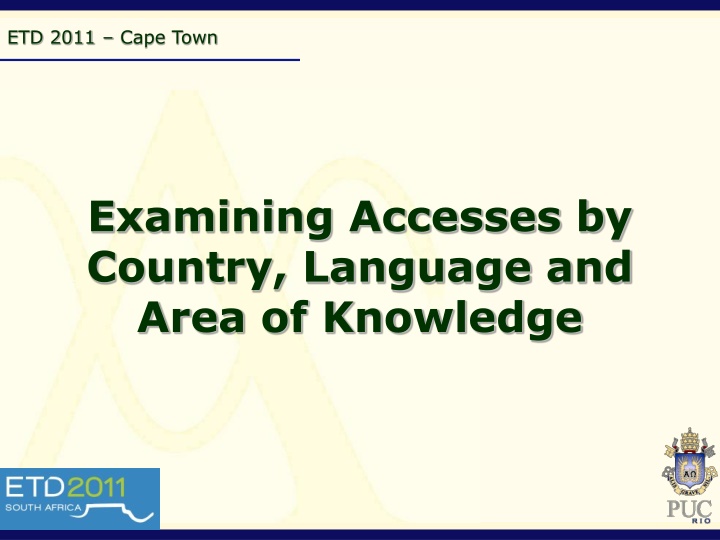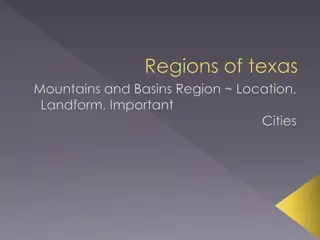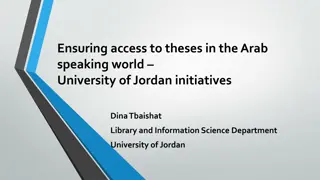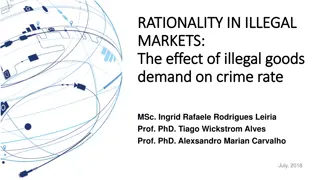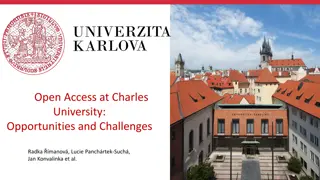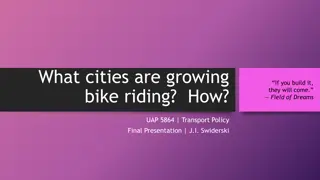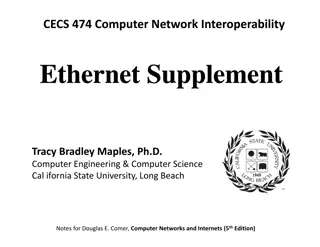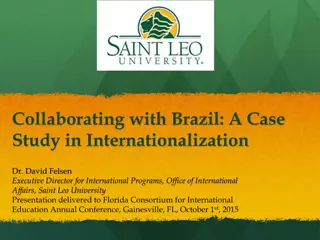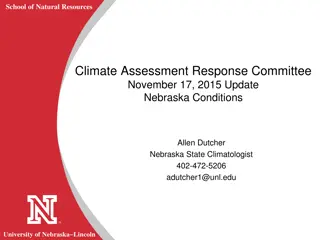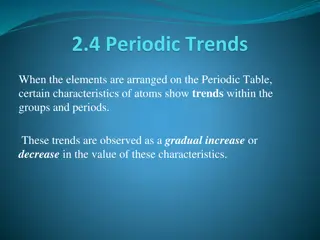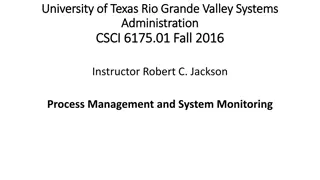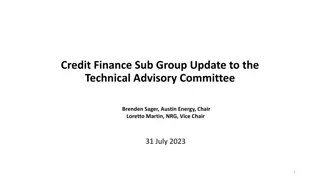Insights into ETD Access Trends and Characteristics at PUC-Rio
The exploration of ETD access patterns and program specifics at PUC-Rio reveals interesting developments such as increased data sets, new country inclusions, and changes in co-authorship. The university's ETD program, divided into three centers, showcases a rich history and a growing repository of electronic theses and dissertations, with mandatory submission since 2002 and a retrospective digitization process in place.
Download Presentation

Please find below an Image/Link to download the presentation.
The content on the website is provided AS IS for your information and personal use only. It may not be sold, licensed, or shared on other websites without obtaining consent from the author.If you encounter any issues during the download, it is possible that the publisher has removed the file from their server.
You are allowed to download the files provided on this website for personal or commercial use, subject to the condition that they are used lawfully. All files are the property of their respective owners.
The content on the website is provided AS IS for your information and personal use only. It may not be sold, licensed, or shared on other websites without obtaining consent from the author.
E N D
Presentation Transcript
ETD 2011 Cape Town Examining Accesses by Country, Language and Area of Knowledge
ETD 2011 South Africa Ana Pavani Laborat rio de Automa o de Museus, Bibliotecas Digitais e Arquivos Departamento de Engenharia El trica Pontif cia Universidade Cat lica do Rio de Janeiro Brazil apavani@lambda.ele.puc-rio.br http://www.maxwell.lambda.ele.puc-rio.br/
This work is a continuation of a work presented last year in Austin. The two works differ in the following aspects: In 2010, there were 71 data sets and this work considers 85 (20% more) East Timor was included because accesses from this country have started happening The UNDP has changed the way HDI is computed, so this data has been updated, as well as the populations of the countries My co-author left the university, so this time I am by myself
PUC-Rio Rio de Janeiro Brazil
PUC-Rio is a small private university. It is divided in 3 centers and each has graduate programs: CTCH (Humanities) 6 CCS (Social Sciences) 10 CTC (Science & Technology) 10 The oldest graduate program (EE) started in 1963. The newest graduate program is less than 5 years old.
Characteristics of PUC-Rios ETD program: First published ETD May 2000 ETDs became mandatory Aug 2002 Number of ETDs 5,694 (Jun 2011) CTCH 1,442 CCS 1,291 CTC 2,961 Yearly average number of defended T&Ds(*) 590 (*) 2007, 2008, 2009 & 2010; (**) 2006, 2007, 2008 & 2009. There is retrospective digitization.
ETDs are made available in chapters (graduate school regulation please, don t ask me the reason!, but it will change as of Oct 2011)
All CTCH CCS CTC Number of ETDs 5,694 1,442 1,291 2,961 Average number of ETDs June 2004 to June 2011 3,553.1 888.9 726.1 1,938.3 Average number of partitions June 2011 7.3 7.9 7.3 7.0 Average of averages number of partitions June 2004 to June 2011 6.93 7.82 6.83 6.57
PUC-Rios ETDs, BDTD(*)and NDLTD(**) : Number of BDTD institutions 97 (OAI-PMH data providers) Number of BDTD metadata records 170K+(BDTD is an OAI-PMH data and service provider) BDTD records are/were harvested by OCLC and other institutions, and made available worldwide Brazilian ETDs are the largest collection in Portuguese available worldwide (*) BDTD Biblioteca Digital de Teses e Disserta es = Brazilian Nat l Consortium. (**) You must know what NDLTD stands for!!!
Accesses to PUC-Rios ETDs: Access logs saved since Jun 2004 Number of monthly logs when article was written 85
Worldwide Western Languages Internet es is the official or one of the official languages of: Portuguese 7th 3rd 6th Argentina Bolivia Chile Colombia Costa Rica Cuba Dominican Rep Ecuador El Salvador Equatorial Guinea (*) Guatemala Honduras Mexico Nicaragua Panama Paraguay Peru Puerto Rico Spain Uruguay Venezuela Spanish 2nd 1St 3rd pt is the official or one of the official languages of: Angola Brazil Cape Verde Equatorial Guinea (*) East Timor (**) Guinea-Bissau Macau (***) Mozambique Portugal Sao Tome and Principe (*) es & pt official (**) less than 5% of the population know it; it was banned during the Indonesian rule (***) UNDP did not publish in the last report; other data were used
Assumptions for the analysis: ETDs are very specialized items people who seek ETDs are highly educated es and pt are quite similar languages educated people who can speak one can read the other es and pt-speakers are potential readers of PUC- Rio s ETDs 2 countries were not considered: Brazil is the home country US there are very large groups of es and pt-speaking persons but neither one is the language of the country
2 groups were defined: international group all countries except Brazil and the US pt+es group all countries that have pt and/or es as one of the official languages Factors considered to influence accesses to ETDs: Population size Level of education Access to the Internet
Sao Tome and Principe has 165K inhabitants Mexico has 110M inhabitants Portugal and Spain are in Europe Argentina and Honduras are in Latin America Angola and Mozambique are in Africa Portugal has 10M inhabitants Equatorial Guinea has the 2 languages Spain has 45M inhabitants
Quantization of potential accesses from countries that are very different : Need to find data on the factors that may influence accesses to ETDs: Population size easy Level of education difficult (literacy rates are easy!) Access to the Internet difficult All data should be considered in the same time-frame Knowledge that the second and the third factors are dependent on how developed countries are Knowlede that it was necessary to combine the 3 factors
Decision on how to deal the countries differences: Use UNDP s HDI Human Development Index that contains information on the second and the third factors (HDI combines indicators of life expectancy, education and income; the new way it is computed contains means years of schooling and expected years of schooling, going beyond literacy rates) Decision to combine HDI with the population size Index I = Population x HDI
All CTCH Total population 420,281,000 57,858,800 Average HDI 0.707 0.527 Index I 309,420,871 25,114,111
Comments: 21 es-speaking and 10 pt-speaking countries (Equatorial Guinea was counted in both) Average HDI for es-speaking countries is 34.16% higher than the other group Population of the es-speaking countries is almost 7.4 times the population of the other group Index I for the es-speaking group is 12.36 times the same index for the pt-speaking group The expectation was to have many more accesses from es-speaking countries than from pt-speaking countries!!
Information: Number of sets of data 85 (one for each month) For each set, 16 variables were computed (examples number of countries, number of pt-speaking countries countries, total number of accesses, etc) All data were computed for the complete set and for each of the 3 areas of knowledge
This analysis focused on the way the whole collection and each individual set CTCH, CCS and CTC were accessed from countries in different groups.
Results: Total number of countries that accessed ETDs 204 CTCH 183 CCS 183 CTC 189 Total number in the international group 202 CTCH 181 CCS 181 CTC 187
Maximum number of countries in the international group in a month 143 CTCH 112 CCS 108 CTC 132 Maximum number of countries in the pt+es group in a month 28 (maximum possible 30) CTCH 27 CCS 27 CTC 27
Number of months with accesses from 100 or more countries 42 CTCH 18 CCS 15 CTC 32 Some percentages follow
% accesses All CTCH CCS CTC from the international group 8.48 7.99 7.89 9.12 in the international group from the es+pt-sepaking group 69.03 73.27 68.56 66.32 in the es+pt-speaking group from pt-speaking countries 82.07 87.11 84.44 77.35 in the international group from pt-speaking countries 56.65 63.83 57.89 51.30 in the international group from Portugal 49.74 57.39 49.54 44.69 in the es+pt-speaking group from Portugal 72.05 78.27 72.26 67.39 in the pt-speaking group from Portugal 87.89 88.92 85.57 87.12
Comments: Absolute values for CTC are higher this area has the largest collection (higher than the sum of the others) Percentages for CTC are lower, except for accesses from the international group Is it more international? It seems that language is not very important in C&T
This analysis focused on the way accesses behaved for the complete collection and how they spread among the sets CTCH, CCS and CTC. The collection and the sets have different profiles numbers of ETDs and numbers of partitions. For this reason, normalization was necessary.
Quantization of potential accesses to sets of works with different profiles: Sets are very different in: Numbers of ETDs Numbers of partitions per ETD This means that numbers of accesses had to be normalized in order to compare accesses to the sets This work presents a first attempt to quantize the way the average ETD in a set attracts accesses
Decision on how to deal the sets differences: Combine average numbers of ETDs with average of average numbers of partitions Index EI = 1 / (average number of ETDs x average of average numbers of partitions)
All CTCH CCS CTC Index EI 0.000041 0.000144 0.000202 0.000079
Average numbers of All CTCH CCS CTC Accesses 740.40 901.73 755.93 644.32 Accesses from the int group 62.77 72.01 59.63 58.79 Accesses from the es+pt-speaking group 43.33 52.76 40.88 38.99 Accesses from the pt-speaking countries 35.56 45.96 34.52 30.16 Accesses from Portugal 31.22 41.32 29.54 26.27 numbers computed for the total numbers of acesses x index EI numbers to be viewed as accumulated monthly averages can be obtained dividing by 85
Comments: When normalized data is consideredn, the average number of accesses (per ETD in Science & Technology) from the international group is the lowest among all The same happens with accesses from the es+pt and pt-speaking groups, and Portugal as well The reason is that ETDs in this group have the lowest average of accesses per ETD among the 3 subsets
When normalized data is considered, the average number of accesses (per ETD in Humanities) from the international group is the highest among all The same happens with accesses from the es+pt and pt-speaking groups, and Portugal as well The reason is that ETDs in this group have the highest average of accesses per ETD among the 3 subsets
Percentage wise, international accesses are the most significant for ETDs in S&T At the same time, the average S&T ETD attracts less international accesses than ETDs in other areas of knowledge and the average Humanities ETD attracts the most In all areas of knowledge, accesses from: es- and/or pt-speaking countries are the most significant pt-speaking countries are the most significant in the es+pt group Portugal are the most significant in the pt-group
New ways of defining attraction should be examined Results seem to indicate that language and HDI are important factors in accesses
Thank you! Muito obrigada!
